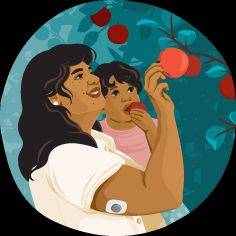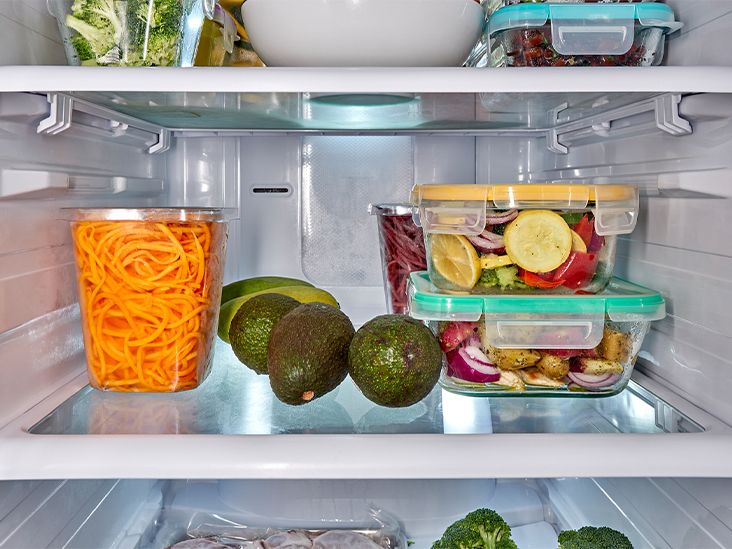Grocery shopping can feel intimidating, especially when you’re trying to hit the trifecta of healthy eating, cost efficiency, and minimal food waste. Here’s how to get started.

Grocery shopping can feel overwhelming, especially with endless choices and confusing labels. As a dietitian, I often hear from clients who don’t know where to start or end up with a cart full of things that don’t support their goals.
In this guide, I’ll walk you through how to shop strategically, from planning and list-making to stocking your kitchen, managing food waste, and keeping grocery bills in check, all while making nutritious choices easier and more accessible.
Walking into a grocery store without a plan is like heading on a road trip without a map. A little preparation goes a long way in helping you stay focused, avoid impulse buys, and make healthier choices.
Start by planning a few meals and snacks you’d like to make during the week. If you’re new to meal prepping, start small. Focus on two to three main meals that can double as leftovers and use overlapping ingredients to
Once you know what meals you want to make, build a grocery list based on those ingredients. Organize it by category or store layout, such as produce, proteins, frozen, pantry, and dairy, to streamline your trip.
A well-structured grocery list helps you shop more efficiently and supports healthier choices. Plus, studies show that grocery lists may help you make healthier choices while shopping.
Try to base your list around whole, nutrient-dense foods such as fruits, vegetables, proteins, whole grains, and healthy fats.
Here’s an example of what a healthy grocery list might include:
- Fruits: apples, blueberries, clementines, grapefruits, and avocados
- Nonstarchy vegetables: broccoli, asparagus, onions, spinach, peppers, and zucchini
- Starchy vegetables: sweet potatoes, baby red potatoes, and butternut squash
- Beans and grains: chickpeas, brown rice, black beans, and quinoa
- Proteins: eggs, canned salmon, skin-on chicken breast, and pea protein powder
- Frozen foods: frozen mixed berries and frozen kale
- Nuts and seeds: roasted almonds, pumpkin seeds, and natural peanut butter
- Dairy and nondairy substitutes: cashew milk, coconut milk, feta cheese, and Greek yogurt
- Condiments: olives, sun-dried tomatoes, salad dressing, olive oil, pesto, and salsa
- Drinks: unsweetened coconut water and sparkling water
- Miscellaneous: ground coffee, dried fruit, dark chocolate, banana plantain chips, and shredded unsweetened coconut
Keep in mind that pantry staples like grains, canned goods, and nut butters don’t need to be purchased weekly. Once you build up your supply, you can do smaller, produce- and protein-focused shops between restocks.
For more detailed healthy shopping list ideas, check out this article.
Meal planning is key to staying organized, reducing food waste, and sticking to your grocery budget. Here’s how to put it into action:
- Start small: Begin by planning 2–3 meals for the week, or batch-cook a grain, protein, and veggie. These base ingredients can be mixed and matched to create multiple meals.
- Choose overlapping ingredients: Select recipes that share common ingredients, which helps reduce both food waste and costs. For example, if you’re using chicken in one dish, consider using it in another meal, like a salad or stir-fry.
- Write your list: Print out your recipes or copy the ingredient lists. This ensures you buy exactly what you need and avoid impulse purchases. When you get to the store, you’ll know exactly what’s on your list, no guessing or second-guessing.
- Take it slow: If you’re transitioning from eating out or takeout, don’t try to overhaul your routine all at once. Start with a few homemade meals and gradually increase the number as meal prepping becomes more natural for you.
- Minimize last-minute takeout: With a plan in place, you’re less likely to resort to last-minute takeout, which can often lead to overspending and unnecessary calories. Plus, having a few ready-to-go meals reduces stress and decision fatigue.
Meal planning is a game changer for your grocery budget and overall health. Start with small steps, and soon you’ll find yourself comfortably preparing healthy meals at home!
Stop by this article for tips on meal prepping.
If you aren’t a fan of frequent grocery store trips, stocking your kitchen with nonperishable and frozen foods is key. This can help you prepare nutritious meals and snacks even when you’re running low on fresh foods.
It’s important to check your cabinets, pantry, fridge, and freezer to take inventory of what you need before going shopping. This can cut down on food waste and ensure that you’ve got the ingredients needed to prepare healthy meals.
You’ll need to purchase fresh items like fresh fruits, veggies, dairy products, and other perishables more often. Meanwhile, nonperishable goods and foods that can be frozen can be purchased less often.
Here are some ideas of long-lasting staples you can keep in your pantry and freezer:
Pantry staples
- Grains: brown rice, oats, quinoa, whole wheat pasta
- Canned goods: beans, lentils, tomatoes, tuna, pumpkin
- Oils and vinegars: olive oil, avocado oil, apple cider vinegar
- Spices and seasonings: garlic powder, cumin, paprika, turmeric
- Nuts and seeds: cashews, sunflower seeds, nut butters
- Shelf-stable milk: oat milk, almond milk, coconut milk
- Baking basics: flour, cocoa powder, maple syrup, vanilla
Freezer staples
- Proteins: chicken breasts, ground turkey, wild salmon, veggie burgers
- Vegetables and fruits: kale, spinach, peas, mango, blueberries
- Bread and grains: whole grain bread, cooked rice, or grains
- Long-lasting extras: frozen herbs, nuts, nut-based flours
With a well-stocked kitchen, your bases will be covered, and you won’t have to stress about buying groceries as often. Just make sure you check your inventory before you go shopping to avoid purchasing items you already have.
Cutting back on food waste isn’t just good for the planet, it’s good for your wallet and your meal prep routine, too. Much of what gets thrown out could have been used with just a bit of planning.
Here are some ways to keep waste low:
- Plan meals using perishable items first, such as leafy greens or berries, earlier in the week.
- Store produce properly to
extend freshnessTrusted Source . Wrap greens in paper towels, keep herbs in water, and use airtight containers for chopped veggies. - Label and freeze leftovers before they go bad.
- Keep a “use me first” bin in your fridge so you can spot aging ingredients at a glance.
- Repurpose extras, such as using your roasted veggies in salads, grain bowls, omelets, or wraps.
Being more mindful of expiration dates, proper storage, and meal rotation can significantly reduce how much food (and money) ends up in the trash.
Healthy eating doesn’t have to be expensive. In fact, with a few smart habits, you can eat well without stretching your grocery budget.
Here’s how:
- Buy in bulk when possible: Grains, dried beans, spices, and nuts are often cheaper in larger quantities.
- Shop store brands: Many are identical in quality to name brands at a lower price.
- Prioritize seasonal produce: It tends to be fresher and more affordable.
- Cook at home more often: Even a few homemade meals each week can dramatically reduce food costs.
- Use digital coupons or loyalty programs.
- Limit convenience foods like pre-cut produce or bottled drinks, which usually come at a premium.
Also, consider meatless meals once or twice a week. Plant-based proteins like beans, lentils, and tofu are cost-effective and versatile.
Grocery stores are designed to encourage more spending, not necessarily healthy choices. But knowing how to move through the store with intention can help.
Start along the perimeter of the store, where you’ll typically find produce, meat, dairy, and other whole foods. After that, move into the center aisles for pantry staples, canned goods, and frozen foods. Don’t avoid entire aisles, just stay focused on what’s on your list.
Ideally, you’ll want to focus on the following when grocery shopping:
- purchasing mainly whole, nutrient-dense foods
- shopping off of your list or weekly meal plan
- not assuming a product is healthy just because it’s labeled with buzzwords (e.g., “gluten-free” or “organic”)
- reading the nutrition labels and ingredient lists of packaged foods
- sticking to your plan and trying to avoid impulse purchases
Finally, try to avoid shopping on an empty stomach, which can lead to impulse purchases. Stick to your plan and resist deals that don’t align with what you came to buy, especially those flashy displays of ultra-processed foods.
Not all packaged foods are unhealthy, but some labels can be misleading. Terms like “natural,” “organic,” or “gluten-free” don’t automatically mean a product is the best choice for you.
When checking labels, try to:
- Look at the ingredient list: Choose products with recognizable, whole-food ingredients.
- Check for added sugars and processed ingredients: If sugar, white flour, or processed oils appear early in the list, consider whether that’s the type of food you want.
- Watch for added sugar: Aim for less than 6 grams of added sugar per serving in items like cereals, bars, and snacks.
- Note the serving size: Make sure the serving size on the label aligns with what you actually plan to eat.
- Trust your judgment: If a label feels overly complicated or confusing, it may be a sign to look for a simpler option.
Reading labels can be confusing. For a detailed guide to reading nutrition labels, check out this article.
Everyone’s needs are different, but here’s an example of a nutrient-dense, versatile grocery cart:
- Nonstarchy vegetables: cauliflower, asparagus, broccoli, sweet peppers, onions, garlic, bell peppers, greens, leeks, and mushrooms
- Fruits: oranges, bananas, apples, grapefruit, lemons, blueberries, pineapple, and avocados
- Proteins: eggs, fish, chicken, ground turkey, and tofu
- Starchy vegetables: sweet potatoes, potatoes, and winter squash
- Grains and legumes: quinoa, oats, brown rice, dried black beans, buckwheat, red lentils, barley, and farro
- Nuts, seeds, and nut butter: pumpkin seeds, macadamia nuts, almonds, and natural peanut butter
- Canned foods: canned salmon, sardines, canned beans, canned pumpkin puree, diced tomatoes, and marinara sauce
- Oils and condiments: olive oil, salad dressing, avocado oil, salsa, apple cider vinegar, balsamic vinegar, dried spices, honey, and maple syrup
- Dairy and nondairy products: Greek yogurt, cheddar cheese, goat cheese, cashew milk, and coconut yogurt
- Snack foods: dark chocolate chips, trail mix, unsweetened dried fruit, and hummus
- Frozen foods: frozen raspberries, frozen shrimp, frozen kale, and whole grain bread
- Beverages: unsweetened seltzer, herbal tea bags, and ground coffee
This list is not exhaustive, but it can act as a general guide for shopping trips.
Of course, there’s also room for your favorite foods in a healthy, balanced diet. The point isn’t to completely avoid foods that are considered less healthy, like chips, ice cream, and cookies.
Rather, a well-rounded diet should prioritize nutrient-dense foods that make you feel good and deliver the nutrients your body needs to thrive, all while leaving room for you to enjoy your favorite foods.
Grocery shopping doesn’t have to be stressful.
Making a list or meal plan, taking inventory of your kitchen, and stocking your freezer and pantry with long-lasting staples can make your shopping trips easier and more enjoyable.
Try using some of the tips covered in this article, and before you know it, you’ll be a healthy grocery shopping pro.
Try this today
Try this today: Before your next trip to the grocery store, choose two dishes you’d like to cook during the upcoming week. Write down a shopping list — or print out the recipe’s ingredient lists — to bring to the store and see whether this helps you make smarter choices.










